
Steamboat Photo Postcards
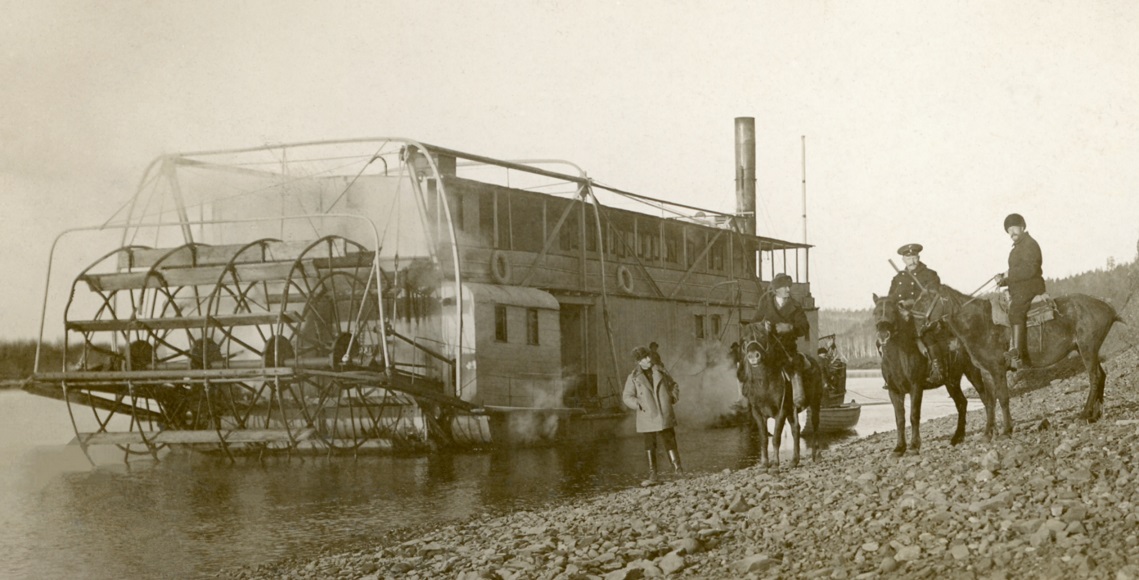
Siberia river steamer RPPC pre 1917 Postcard
Received this image today at last after a voyage of quite a few weeks from the Ukraine.
Can you hear the Balalaikas playing Maurice Jarre's Lara's theme from DR. ZHIVAGO?
Pre Russian Revolution Cossacks on horseback pose on shore next to a sternwheel steamboat on one of the 3 rivers in Siberia which are the Ob, Yenisei and Lena that all flow into the Arctic Ocean.
LISTED AS: "Siberia river steamer RPPC pre 1917"
This real photo postcard came from an eBay dealer "oldpaperua" in Kiev, Ukraine
Kiev or Kyiv (Ukrainian: Київ, Russian: Киев, Kijev [the capital and largest city of Ukraine, located in the north central part of the country on the Dnieper River.
Wikipedia
Siberian River Routes were the main ways of communication in the Russian Siberia before the 1730s, when roads began to be built. The rivers also were of primary importance in the process of Russian exploration and colonization of vast Siberian territories. Since the three great Siberian rivers, Ob River, Yenisei River and Lena River all flow into the Arctic Ocean, the problem was to find parts or branches of these rivers that flow approximately east-west and find short portages between them. Since Siberia is relatively flat, portages were usually short. Because of this, and the weakness of the Siberian tribes, Russian Cossacks were able to expand from the Urals to the Pacific in only 57 years (1582-1639).
The southern border of Siberia corresponds to the forest-steppe boundary. Russian penetration of Asia was confined to the forest zone because the cossacks had the skills to travel through river and forest, because the native peoples were few and weak and because their expansion was paid for by the fur trade. Unlike Russia proper, there was little attempt to penetrate the steppe. Road building began in the 1730s. Although there were always some peasants, massive peasant colonization did not begin until the 1860s. The Trans-Siberian Railway began in 1891. In the twentieth century highways were built, but the stretch north of the Amur is still not complete. It goes without saying that all of this development took place as far south as possible. The result is a pattern in which the Russians form a long narrow belt along the southern border with some extensions northward, mainly to where minerals can be found. The rivers are still used, but largely for north-south transport to and from the Trans-Siberian Railway.
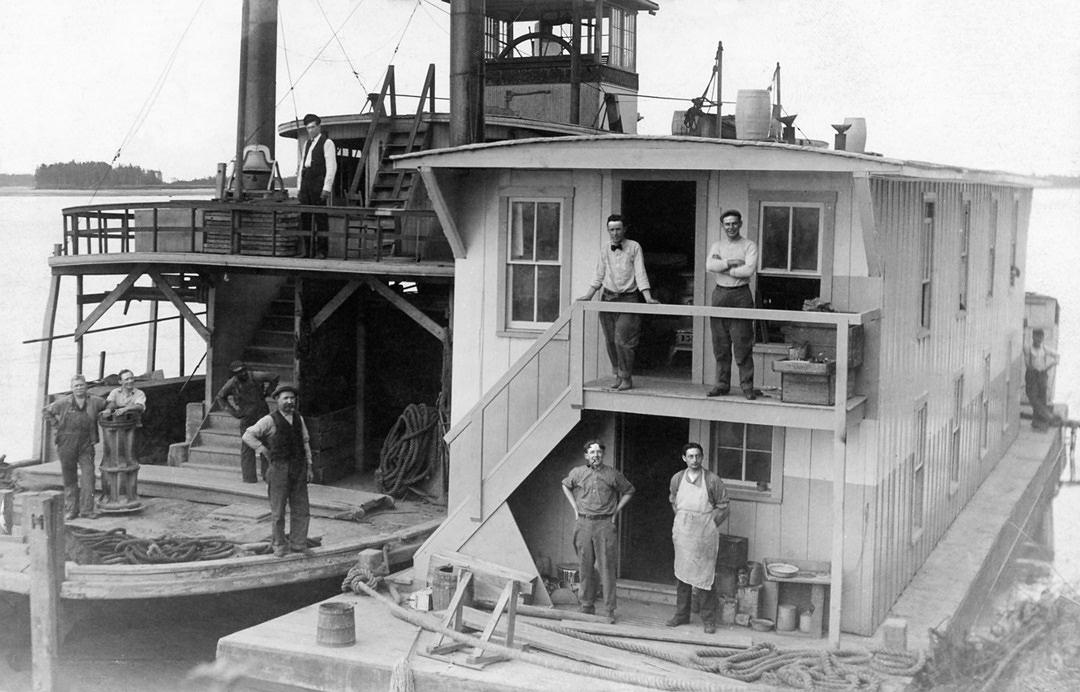
J.R. WELLS IS APPARENTLY THE BOAT IN THE LEVASY, MISSOURI POSTCARD
Attached is the best of 3 real photo postcards sent from Levasy, Missouri in September and December, 1910 from "Aunt Josie" to her niece, Mrs. R.O. Hutchins in Rifle, Colorado. Levasy, Missouri is inland 4 miles west of the south shore of the Missouri River where Napoleon, Missouri is located, which suggests that this image of the J.R. WELLS and quarter boat could have possibly been taken in the vicinity of Napoleon.
The first of the other two cards that accompanied the attached postcard were written and post marked Sept 17th, 1910 Levasy, Missouri from Aunt Josie to her Niece in Colorado: "This card is (of) the Rip Rap gang that Elmer worked with last Spring on the River. He has a large cross on his back in pencil you will see. He is bent over hoping to hear from you soon and to see you very soon after you get back."
Written and post marked Levasy MO Dec 11, 1911 from Aunt Josie to her Niece in Colorado: "Ma has been sick but is better now. We had a terrible tragedy near here last week. A man shot and killed his wife and himself. Jack has caught 23 rabbits this winter and they are fine to eat this year. Jack is going up to your parents tonight."
J.R.WELLS
Miller County Historical Society Museum
February 28, 2015 Facebook
Additional history here: millercountymuseum.org
In 1898, the Anchor Milling Company, desiring to expand its business, began the construction of a boat at Tuscumbia to be 110 feet long and with a 20-foot beam. This boat became known as the J.R. WELLS, so named after one of the principal stockholders of the Anchor Milling Co.
The WELLS did an extensive business on the Osage River, with Capt. John W. Adcock as pilot, later with Capt. P.F. Hauenstein. Local crews were employed on this boat, and during the boating season it was almost continuously engaged in hauling out wheat, barites, lumber, livestock, kaolin and other products as well as bringing up merchandise from Osage City and Hoecker.
The Anchor Milling Company also built a large barge, the IDA, which was used to advantage in the Osage River service. The WELLS and its barge could handle approximately 6,000 bushels of wheat at a trip.
The DAUNTLESS was another steamboat which was built at Tuscumbia about the time the J.R. WELLS was launched. The DAUNTLESS was equipped with a tubular boiler, and was about 60 or 75 feet in length. It was built by a company of Tuscumbia businessmen for general freighting on the Osage. The RUTH, another boat built by J.R. Wells, was later operated in traffic by the Anchor Milling Company.
Wikipedia
The Osage River is a 276-mile-long tributary of the Missouri River in central Missouri in the United States. The Osage River is the 8th largest river in Missouri. The river drains a mostly rural area of 15,300 square miles. The watershed includes an area of east-central Kansas and a large portion of west-central and central Missouri where it drains northwest areas of the Ozark Plateau. The river flows generally easterly, then northeasterly for the final 80 miles where it joins the Missouri River. It is impounded in two major locations. Most of the river has been converted into a chain of two reservoirs, the Harry S. Truman Reservoir and the Lake of the Ozarks.
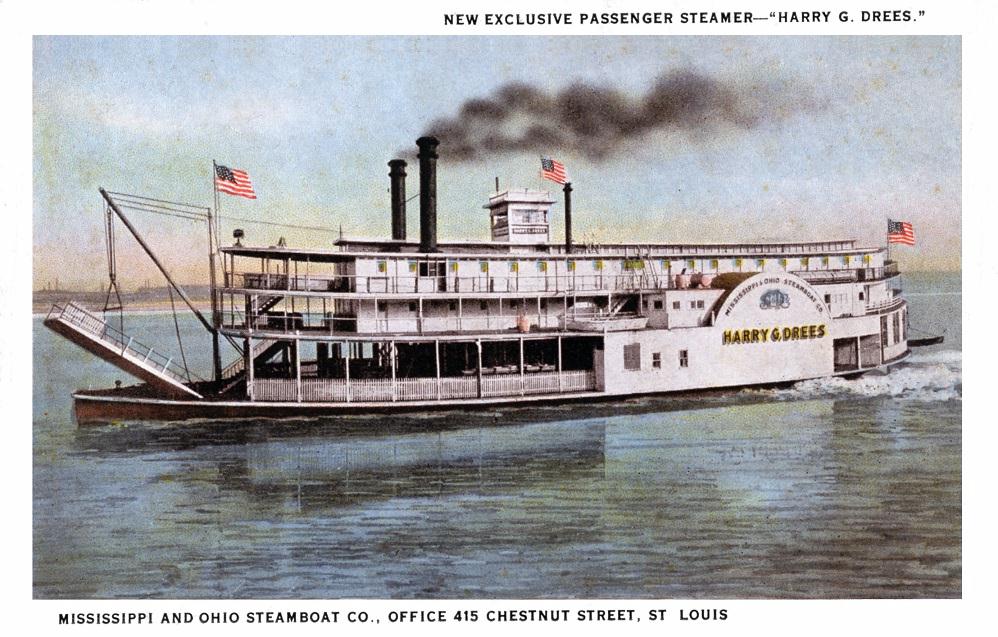
Harry G. Drees - a "living color" postcard
Promotional card excursion steamer HARRY G. DREES circa the 1920s
Attached fully restored promotional postcard that dates circa the 1920's. Lettering and outlines around pictures are now freshened up. Upgraded the photos that were on the original card of the starboard view of the boat and the cabin with far better quality ones from the La Crosse collection.
HARRY G. DREES
Sidewheel Excursion boat/Packet
Way's Packet Directory Number 2538
Built as the PILGRIM in 1917 at the Howard Ship Yards - Jeffersonville, Indiana. Remodeled into a tourist boat in 1924 by the Mississippi and Ohio Steamboat Company and renamed HARRY G. DREES after the new owner. Ben Winters was Captain during the mid-1920s. The DREES ran between St. Louis and St. Paul and often got stuck on sand bars due to her deep draft. She had 80 state rooms, shower baths, hot and cold water, toilets and electric lights. Was finally sold to Tampa, Florida where she gradually fell apart.
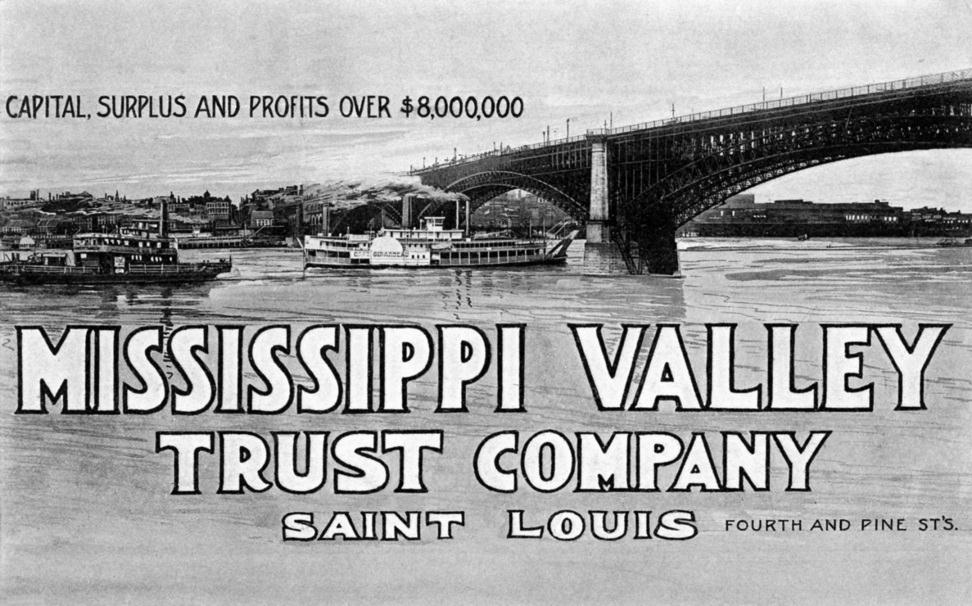
Mississippi Valley Trust Co. St. Louis 1909
Promotional grayscale postcard postmarked 28 Sept 1909 ST. LOUIS, MO to Mr. John Roberts in Emporia, Kansas with the message "We arrived safe. Sis."
The Mississippi River waterfront at St. Louis is featured with the Eads bridge on the right and the steamboat CAPE GIRARDEAU visible at center.
Wikipedia
The Mississippi Valley Trust Company Building is a historic building at 401 Pine Street in Downtown St. Louis, Missouri.
The two-story building was completed in 1896. It was designed by architectural firm Eames & Young in the Beaux-Arts architectural style.
It was home to the Mississippi Valley Trust Company, a local bank which "financed transportation and communication networks in the St. Louis region, and was a supporter of the St. Louis World's Fair." The bank was later acquired by the Mercantile Bancorporation which was in turn acquired by the Firstar Corporation, and eventually U.S. Bancorp. Later, the building was home to a restaurant. Today it is used as office space.
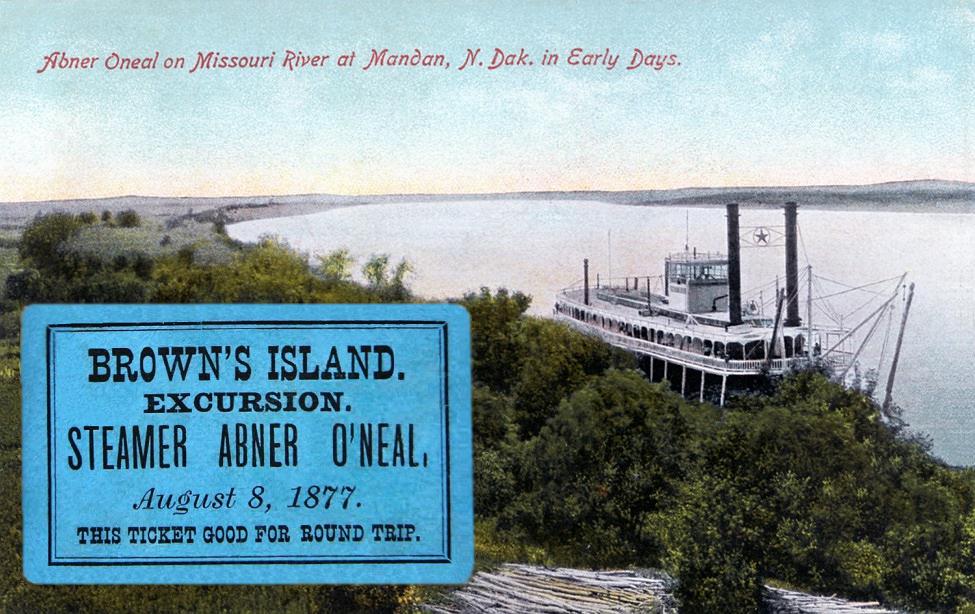
ABNER O'NEAL
Sternwheel Packet
"Abner Oneal (sic) on Missouri River at Mandan, N. Dak. in Early Days"
Lithographed postcard post marked 29 March, 1912
Way's Packet Directory Number 0043
Built in 1884 at Freedom, Pennsylvania; completed at Wheeling, West Virginia.
Valued at $12,000.
Captain Nate Wintringer; Captain George O'Neal
Sold to Missouri River Transportation Company on March 31, 1890
Captain R.A. Talbott, W.L. Wilkins, clerk.
Snagged and sank at Painted Woods, North Dakota on July 17, 1892
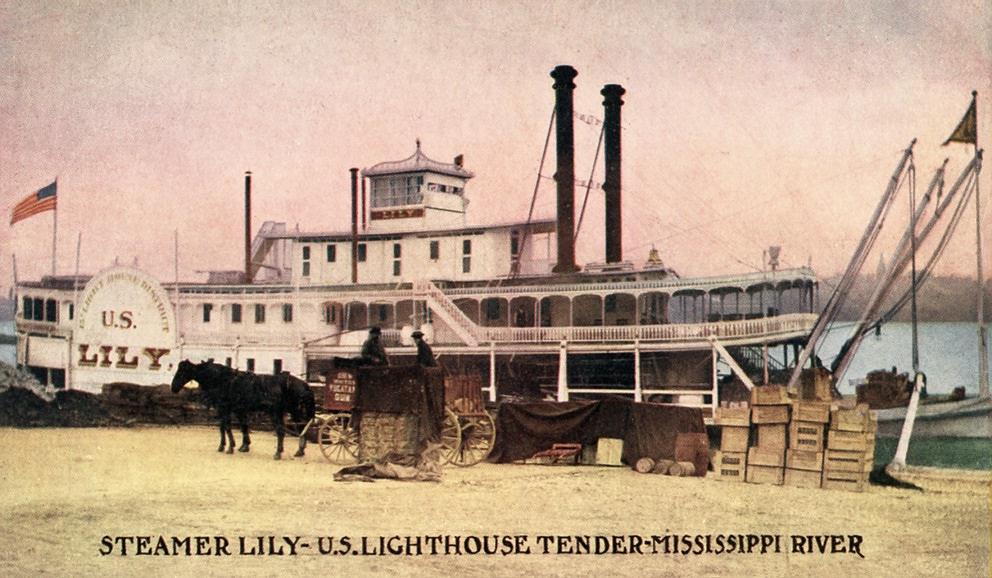
Lighthouse Tender LILY 1908 postmarked at Davenport, Iowa on the Mississippi.
Lithographed color postcard postmarked 16 July, 1908 at Davenport, Iowa on the Mississippi. Frequently photographed, there are a number of good images of LILY in the La Crosse collection and John Stobart painted and atmospheric canvas of the LILY at night on the St. Louis waterfront with the Eads Bridge in the background.
LILY
Lighthouse tender
Sidewheel
Way's Packet Directory Number 3471
Built in 1875 at Louisville, Kentucky for the U.S. Engineering Department
Began in service on the Ohio River. In 1888, she burned off her upper works and was completely rebuilt with a new hull and texas. The old hull became a wharfboat at Madison, Indiana. After being rebuilt, the LILY went to the upper Mississippi and Missouri rivers. She serviced beacon light buoys between St. Paul, Stillwater and the St. Croix River and St. Louis for many years. She was also the guard boat for the President's fleet.
On October 17, 1911 she snagged near Wellington, Missouri. On November 24, 1911, she snagged again near St. Albans, Missouri, mile 49 on the Missouri River at the head of Centaur Chute and was lost . She was the first lighthouse tender on the upper Mississippi.
Officers & crew:
Captain Owen B. Jolly (1875); Captain William R. Hoel (1875); Captain George Vandergrift (1885); Captain Charles Dufour; Captain William Eagon (master); Campbell Hunt (pilot, 1910, 1911); M.H. Crapster (master, 1892); William C. Egan (chief engineer); Dick Stevens (pilot); J.H. Duffer (commander, 1888); Jim Carrew (pilot, 1894); George Farnsworth (pilot, 1894); A.B.H. Lily (commander, 1894); James W. Swayze (commander, 1891); Robert W. Wise (commander, 1894); Washington P. Hight (1897); Richard Stevens (pilot, 1895); Mayo Dorsey (pilot, 1897); John Clark (pilot, 1897)
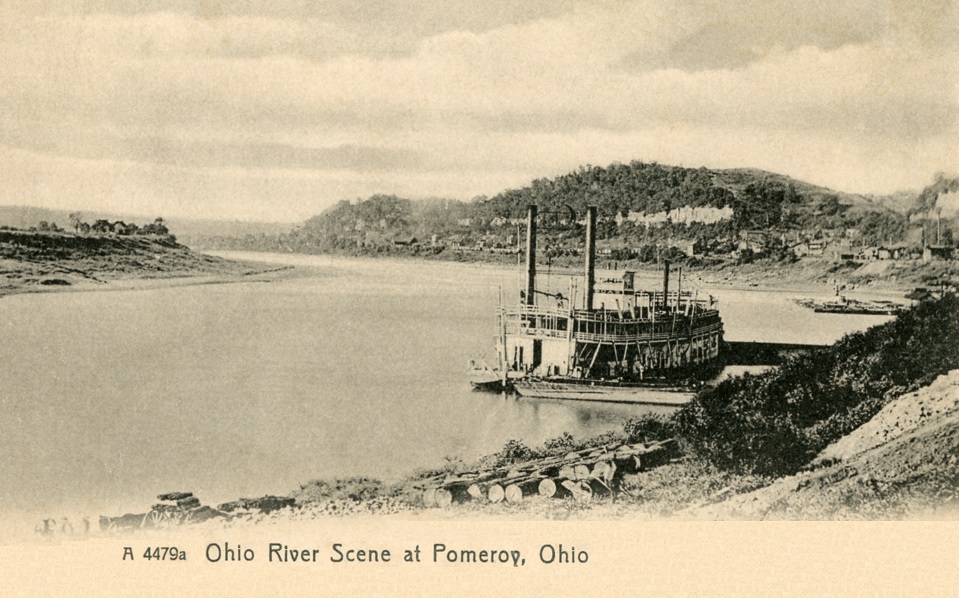
Towboat BOAZ Pomeroy, OHIO 1906
Rotogravure postcard postmarked 29 Dec 1906 Pomeroy, Ohio
BOAZ
Sternwheel towboat Boaz
Built at Sewickley, Pennsylvania, 1882.
Ran Pittsburgh to Cincinnati 1908.
Dismantled in 1925.
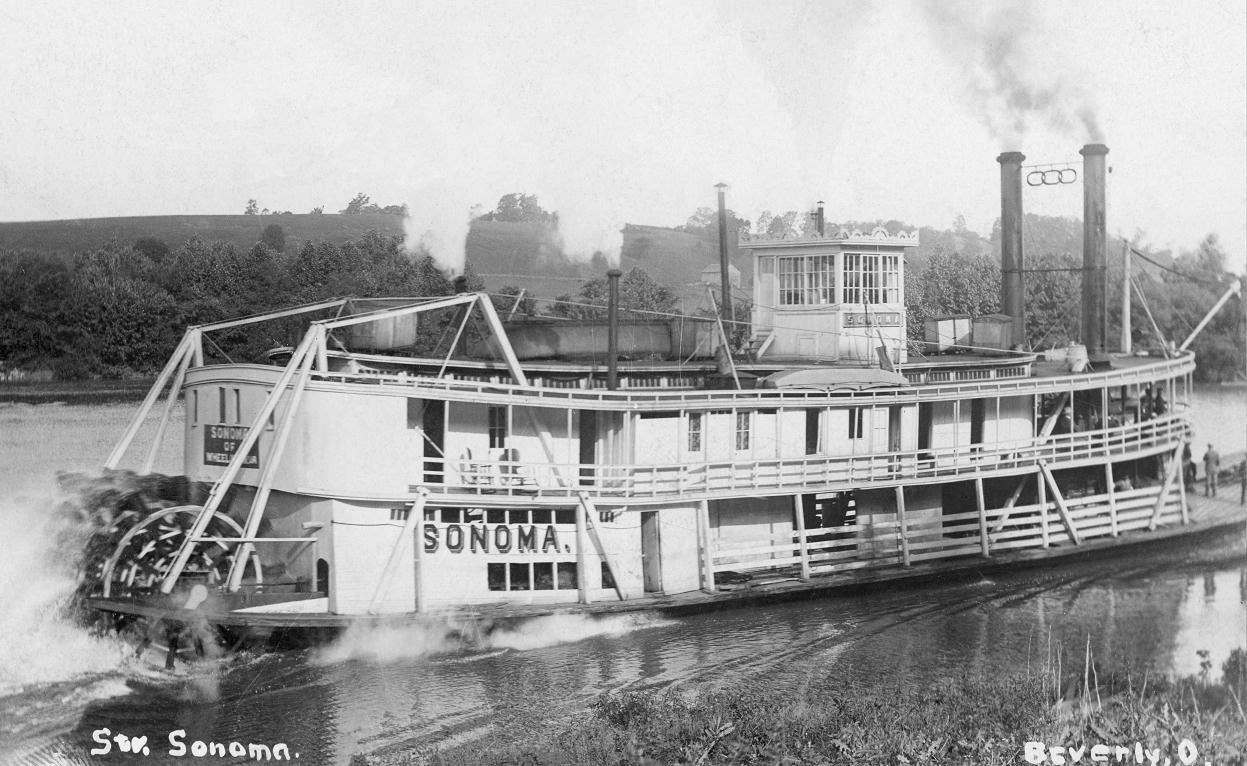
Steamer SONOMA
Nice newly acquired and then enhanced real photo post card of the SONOMA Postmarked 15 December 1909 in Waterford, OHIO
SONOMA (1881-1913)
Way's Packet Directory Number - 5139
Sternwheel Packet
Built 1881 at Harmar, Ohio at the Knox Yard
Owned by Captain Edmund B. Cooper & Captain E.W. Webster
Captain Cooper ran her on the Ohio River, Parkersburg-Belleville.
In December 1892 she ran daily on the Muskingum River, Marietta-Beverly.
She also made some trips on the Big Sandy River.
In 1897, Captain Webster enlarged her at Parkersburg.
She made daily trips Marietta-Beverly from 1893 to 1909.
From 1909 to 1910, she ran Marietta-McConnelsville.
She sank, while down bound, at Lem Lawrence's landing between Beverly and Luke's Chute on April 19, 1910.
The LORENA took her freight and the towboat DARLING pumped her out.
In 1911 she ran excursions and substituted for the H.K. Bedford in the Pittsburgh-Parkersburg trade.
On May 12, 1905, she took Theodore E. Burton, chairman of the Congressional Rivers and Harbors Committee, plus ten others up the Muskingum River, 10 miles from Marietta.
By 1913, the SONOMA was in the Madison-Frankfort trade when she turned over and sank on the 3rd of May that year after she hooked a snag while backing out of a Kentucky River landing one mile above Glen Mary in Henry County. Captain Webster quit the river after the sinking.
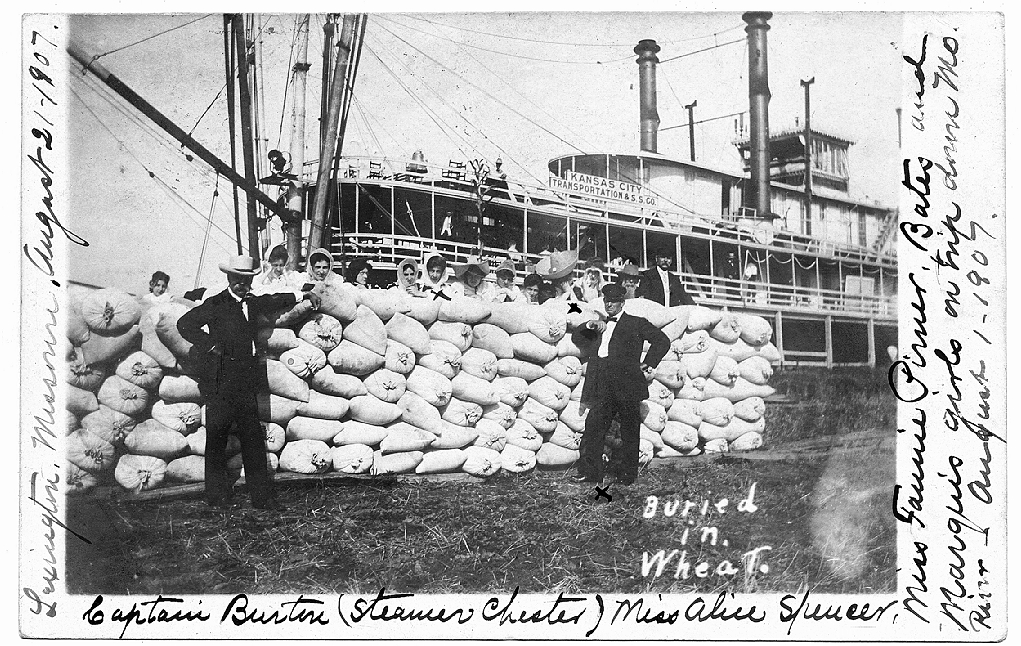
The attached postcard of the Chester is one of the weirder ones with the bevy of young ladies, were the "Marquis girls" vaudevillians or "fancy wimmen"? . . . they're too old to be school girls. And why the Mexican straw hats? Captain looks like Will Rogers. I like the geezer with the huge beard that looks like a disguise.
In the margins is written:
"Lexington, Missouri, August 21 -1907 Captain Burton (Steamer Chester) Miss Alice Spencer Miss Fannie Pirner (?) Bates and Marquis girls on trip down Mo. River - August 1- 1907."
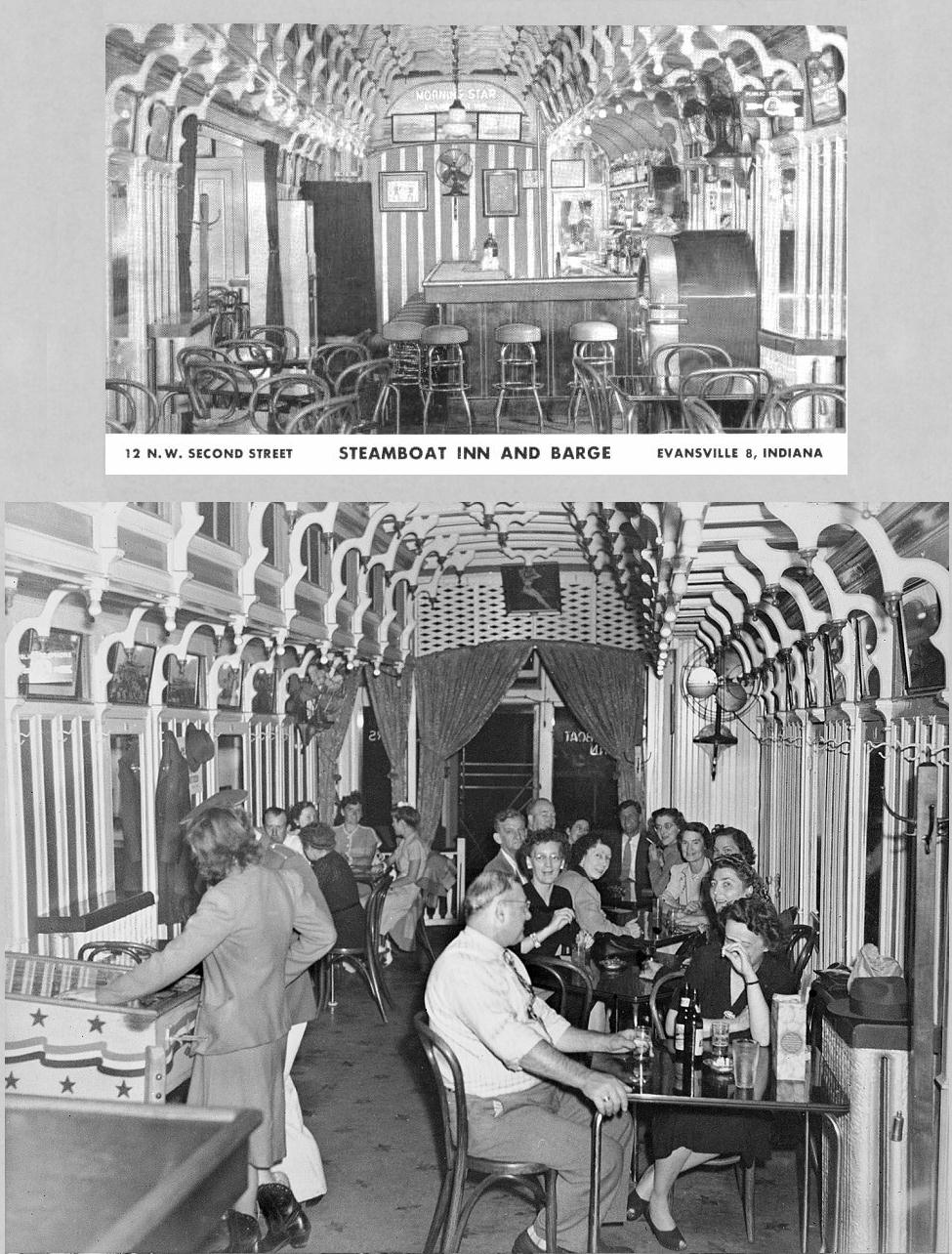
Postcard of the "Morning Star Bar" located in the "Steamboat Inn & Barge" restaurant at 12 Northwest Second Street in Evansville, Indiana. Picture taken between 1945 and 1954
Below the postcard is a photo of folks enjoying beer and cocktails. A young couple are playing a pin ball machine on the left. The girl is wearing cowboy boots and the young man is wearing a uniform cap and coat along with a pair of white bell bottom trousers.
This photo was taken from the bar area looking towards the street entrance with the tail end of the words STEAMBOAT INN visible on the window to the right.
The interior of the Inn was made from parts salvaged from an actual steamboat cabin, probably from the MORNING STAR. Have heard that after the place closed that the arches and other architectural details were carefully removed and put into storage somewhere in Evansville. Hopefully some day they will be resurrected and reassembled in a suitable place.
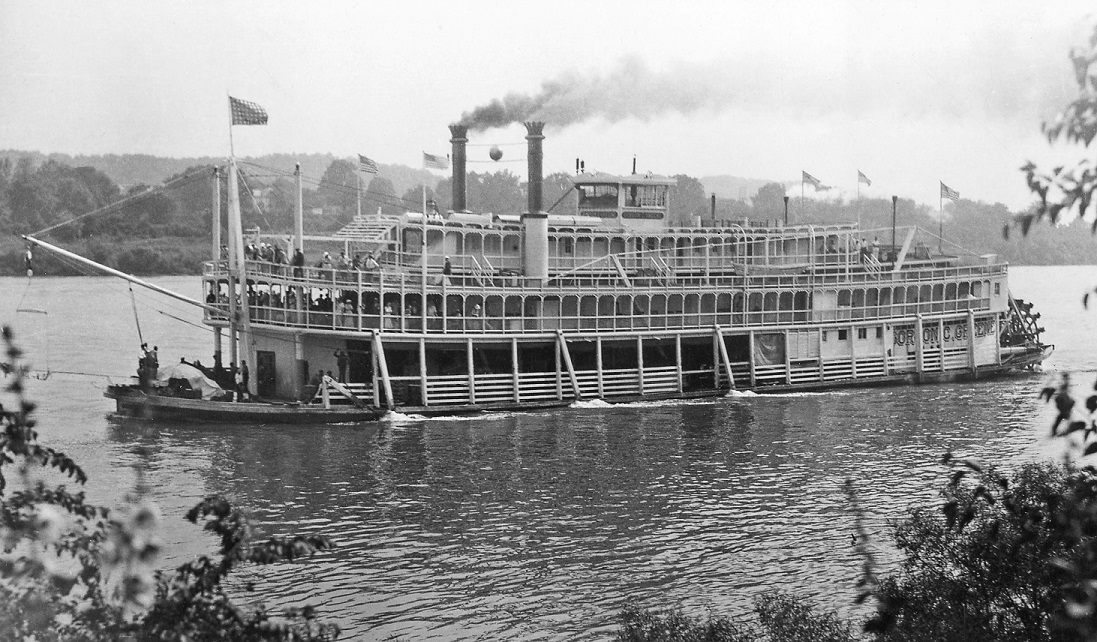
The Gordon C. Greene, Cincinnati.
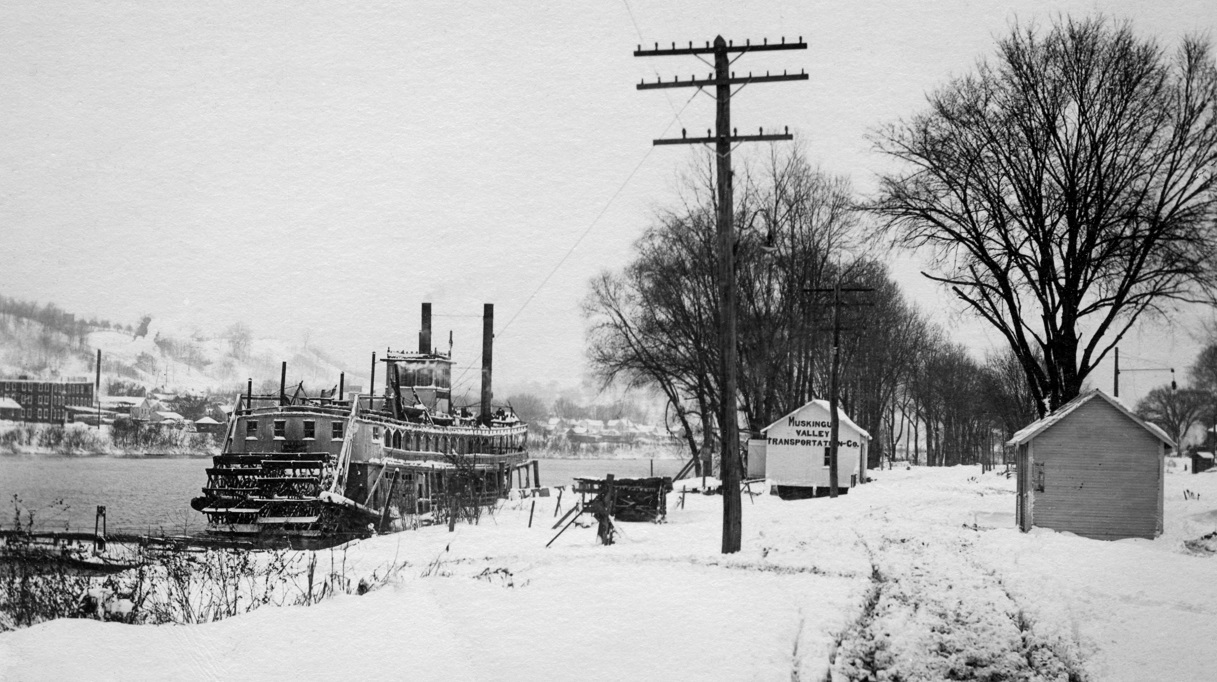
This just in from a dealer in Germany, an unusual wintertime real photo postcard of the VALLEY GEM dated 10 November, 1913. On the right is a small frame building with signage painted on it: MUSKINGUM VALLEY TRANSPORTATION CO. Likely location was somewhere in the vicinity of Marietta, Ohio.
VALLEY GEM Sternwheel Packet
Way's Packet Directory Number 5535
Built for the McConnelsville-Zanesville trade on the Muskingum River in 1897 at Harmar, Ohio at Knox Yard From 1898-1917 she ran this trade, making one round trip a day.
Owners in 1898: Captain Newton Price, C.F. Siler; J.H. Shipps, Charles F. Hearing, H.S. Shaner and Lee Humphrey.
McLaughlin [first name unknown] was the (pilot in 1900)
Captain J. Orville Noll (owner and master, 1917-1918); T.M. Price (clerk)
Captain Noll bought her in 1917 to use in the Pittsburgh-Fairmont trade on the Monongahela River.
She was the last packet in the Fairmont trade. Destroyed by ice at Morgantown, West Virginia in February 1918.
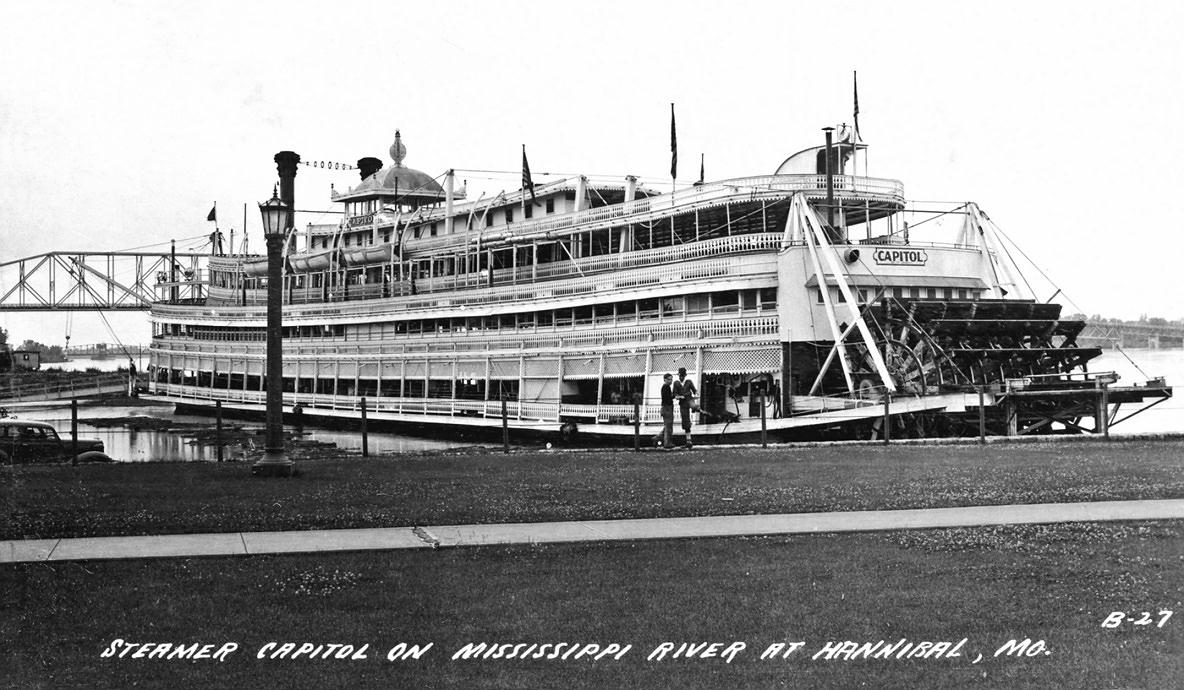
Real photo postcard post of the excursion steamer CAPITOL at Sam Clemens' hometown.
post marked HANNIBAL JULY 6, 1940
Addressed to Mr. & Mrs. W.R. Finney Mansfield, Ohio
message:
"Hi Folks
We're way down here in Missouri where it's hotter than blitzen.
Wish you were here.
Bob & Marialier"
I gather "blitzen" is used in one of the several German translations as "lightening." There are several ladies "Maria Lier" listed online including a Norwegian girl born in 1818. Bob's traveling companion may have made a "portmanteau" name by combining the two names which are still in use today.
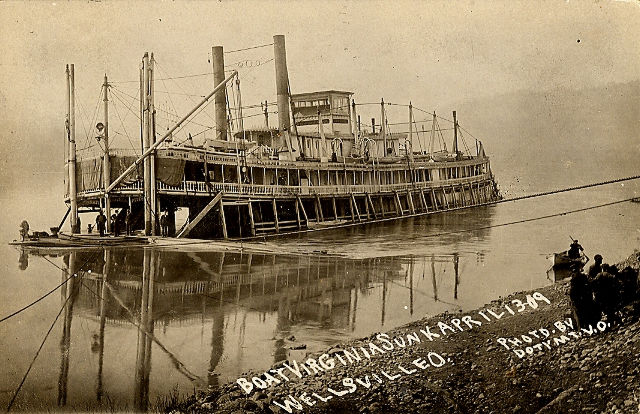
Self explanatory real photo card of the Virginia sunk at Wellsville, Ohio, April 13, 1909.
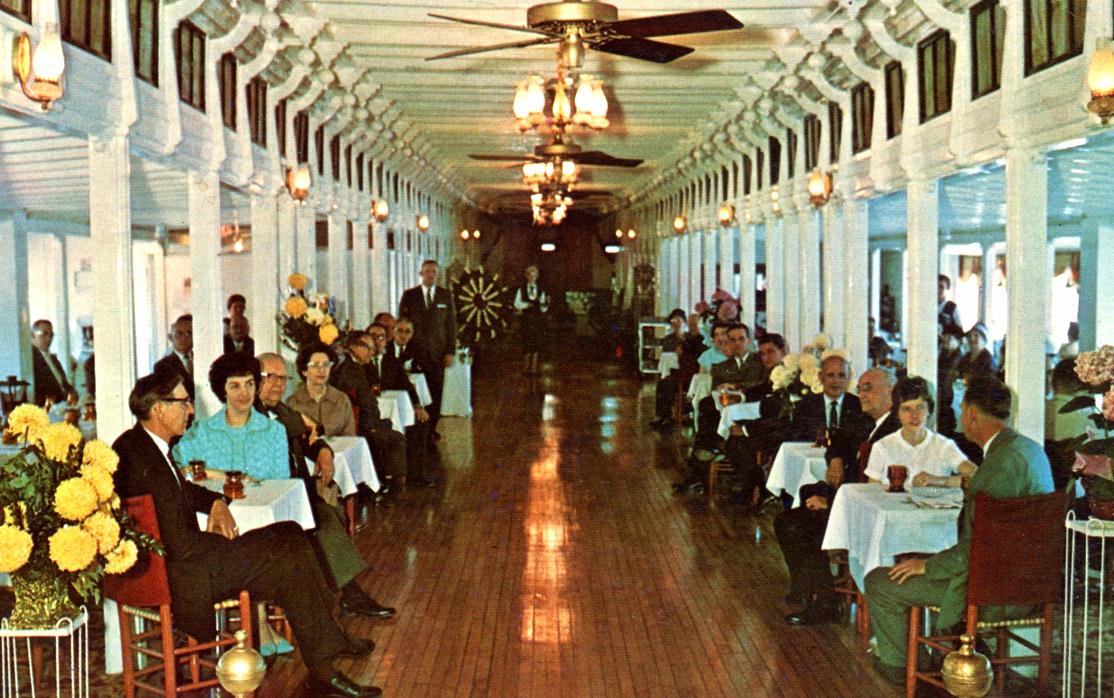
The River Queen, after it ended service as an overnight passenger vessel, became a static tourist attraction with a restaurant and bar. This color postcard shows the restaurant-bar area.
The postcard was postmarked 1963 from Hannibal, MO where the RIVER QUEEN was moored on the north side of the Mark Twain Memorial Bridge on the Illinois shore opposite Hannibal. The color postcard is pretty corny compared to the black and white image which is relatively classy by comparison.
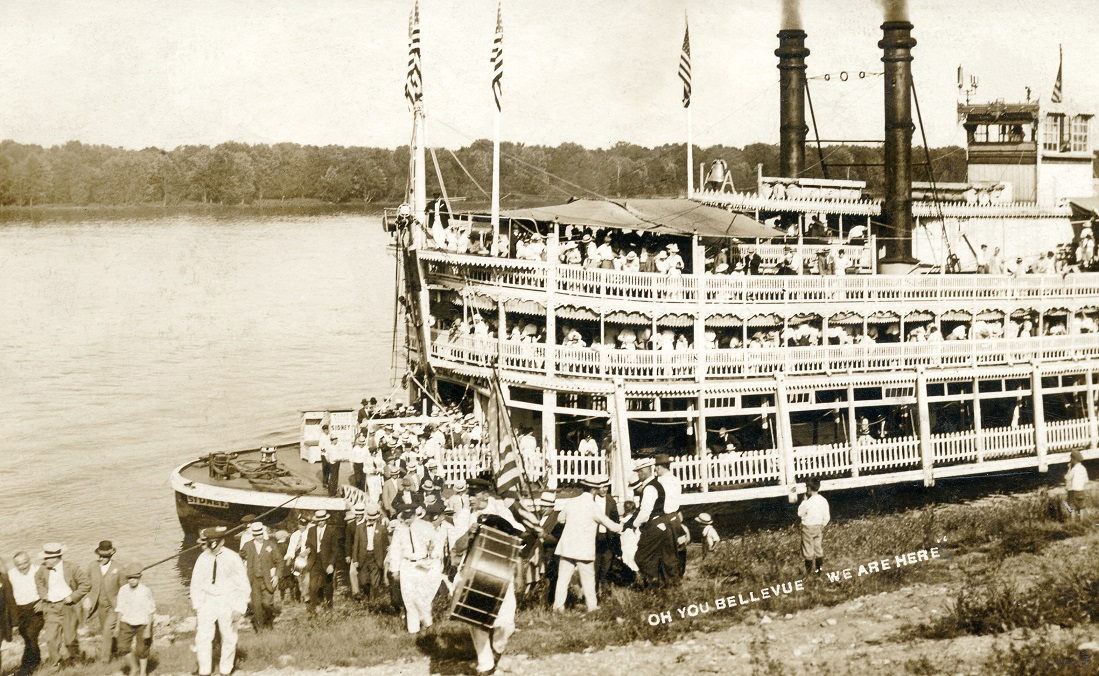
Postcard with August 19, 1916 postmark.
The name on the hull below the deck at the bow says SIDNEY, big as life. We've got an old newspaper ad from a Hannibal paper for an excursion for her on one of the new pages.
Note the musician with the big bass drum in the left foreground with some fellows following him up the river banks who are wearing the same uniform, probably band players also.
Four U.S. flags are on flag poles aboard the SIDNEY and at least one flag is being carried ashore among the passengers who may be bound for a picnic at a riverfront park.
It addition to the folks disembarking there are plenty of passengers still on the boat. 'appy 'oliday!
A paragraph about the SIDNEY from "RIVERBOATS & JAZZ" on a Tulane University site:
Tulane.edu
The SIDNEY was commissioned in 1911 and remained in the Streckfus fleet under that name until 1924, when it was renamed the WASHINGTON. This was the first boat to feature a New Orleans band on the river, and it helped to spread the word about the special talents of Crescent City musicians. Fate Marable had formed a band of fellow Kentuckians in 1917, but he later recalled that while they "played real nice, they could not compare to the New Orleans boys." The Streckfus excursions ran from New Orleans to St. Paul, Minnesota, allowing numerous opportunities for patrons up and down the Mississippi River to hear what these players had to offer. Thus, musicians in places such as St. Louis, Missouri, and Davenport, Iowa, gained exposure to New Orleans style music, although it was confined to some extent by the guidelines set down by Marable and Captain Joe Streckfus. Even so, musicians and dancers alike could tell that New Orleans players were somehow different. As Captain C. W. Elder claimed, "None of the others had what was called good solid beat rhythm music with the Dixieland flavor."

With the exception of images credited to public institutions,
everything on this page is from a private collection.
Please contact Steamboats.com for permission for commercial use.*
All captions provided by Dave Thomson, Steamboats.com primary contributor and historian.
